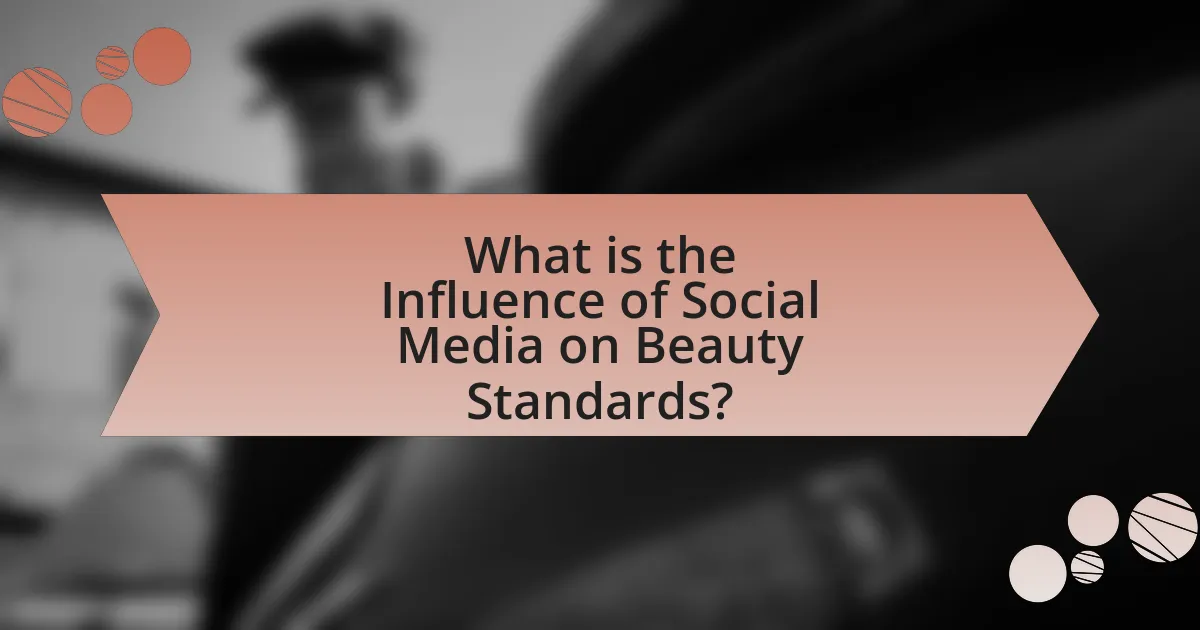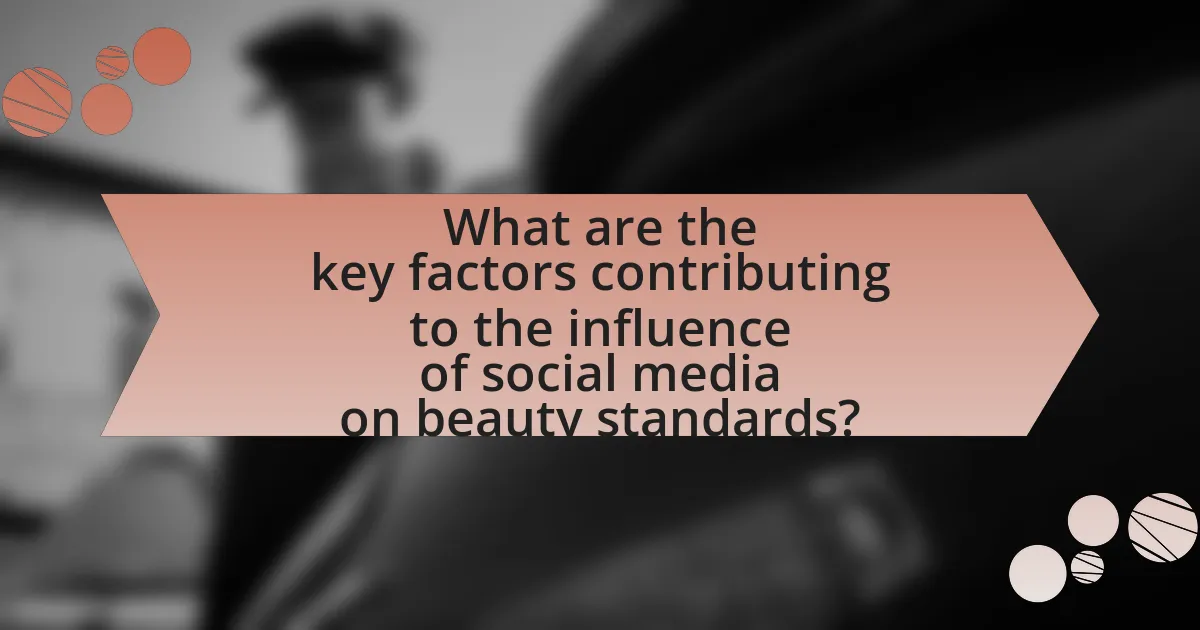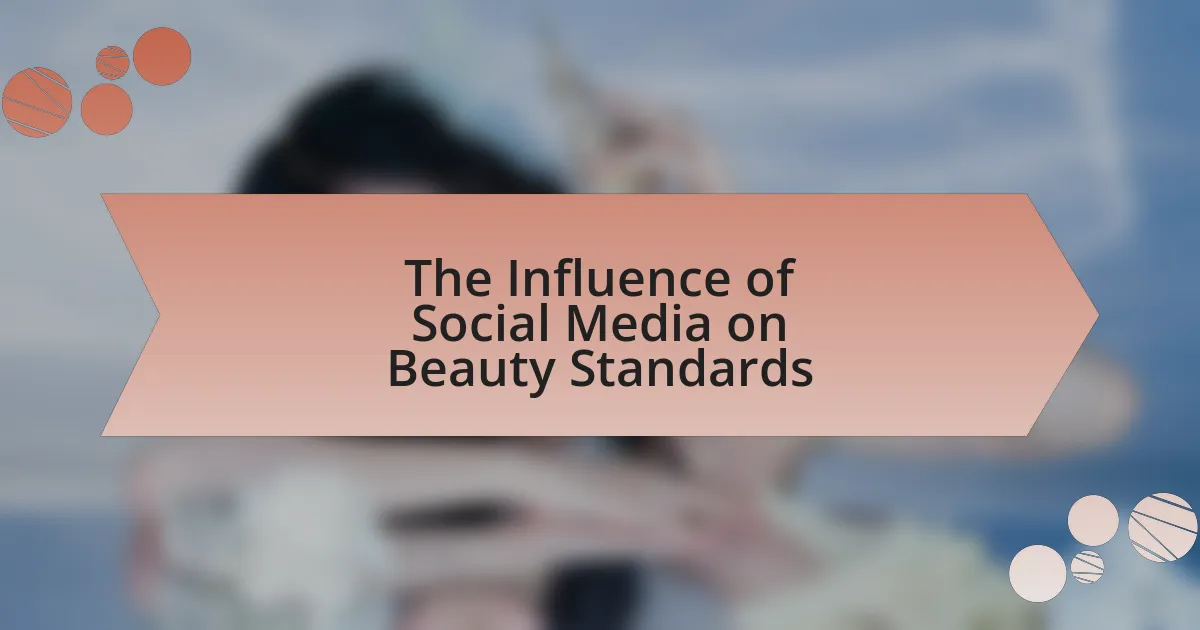The article examines the significant influence of social media on beauty standards, highlighting how platforms like Instagram and TikTok promote idealized images that shape public perceptions of attractiveness. It discusses the psychological effects of exposure to these curated beauty ideals, including body dissatisfaction and lower self-esteem, particularly among young women. The role of influencers in setting trends and the varying impacts of different social media platforms on beauty perceptions are analyzed. Additionally, the article addresses the societal implications of changing beauty standards, the emergence of movements advocating for body positivity, and practical steps individuals can take to navigate these standards effectively.

What is the Influence of Social Media on Beauty Standards?
Social media significantly influences beauty standards by promoting idealized images and trends that shape public perceptions of attractiveness. Platforms like Instagram and TikTok often showcase filtered and edited photos, leading to unrealistic expectations regarding physical appearance. Research published in the journal “Body Image” indicates that exposure to idealized beauty images on social media correlates with body dissatisfaction and lower self-esteem among users, particularly young women. This influence is further amplified by the prevalence of influencers and celebrities who set trends, often prioritizing specific body types, skin tones, and styles that may not represent the diversity of real-life beauty.
How has social media changed perceptions of beauty?
Social media has significantly altered perceptions of beauty by promoting diverse representations and setting new standards that often prioritize curated aesthetics over traditional ideals. Platforms like Instagram and TikTok showcase a wide range of body types, skin tones, and styles, challenging the narrow definitions of beauty that have historically dominated mainstream media. Research indicates that exposure to diverse beauty representations on social media can enhance body positivity and self-acceptance among users, as seen in studies published in the Journal of Social and Clinical Psychology, which highlight the positive impact of inclusive beauty content on self-esteem.
What role do influencers play in shaping beauty ideals?
Influencers play a significant role in shaping beauty ideals by promoting specific standards of attractiveness through their curated content on social media platforms. Their reach and engagement allow them to set trends and influence perceptions of beauty, often showcasing particular body types, skin tones, and styles that resonate with their followers. Research indicates that 70% of teenagers trust influencers more than traditional celebrities, highlighting their impact on shaping beauty norms. Additionally, influencers often collaborate with brands to promote products that align with these ideals, further reinforcing the standards they establish.
How do social media platforms differ in their impact on beauty standards?
Social media platforms differ in their impact on beauty standards primarily through their user demographics, content formats, and algorithms. For instance, Instagram emphasizes visual content, promoting curated images that often reflect idealized beauty, which can lead to unrealistic standards among its predominantly young female user base. In contrast, TikTok’s short-form video format encourages a more diverse representation of beauty, allowing for trends that celebrate individuality and authenticity, which can positively influence self-image. Research indicates that platforms like Facebook, which focus on community and connection, may foster discussions around beauty that challenge traditional norms, thereby promoting a broader acceptance of various beauty standards. These differences highlight how the unique characteristics of each platform shape users’ perceptions and attitudes toward beauty.
Why is understanding this influence important?
Understanding the influence of social media on beauty standards is important because it shapes societal perceptions of attractiveness and self-worth. This influence can lead to significant psychological effects, such as body dissatisfaction and low self-esteem, particularly among adolescents and young adults. Research indicates that exposure to idealized images on platforms like Instagram can increase the likelihood of developing eating disorders and mental health issues. For instance, a study published in the journal “Body Image” found that individuals who frequently engage with beauty-related content on social media report higher levels of body dissatisfaction. Therefore, recognizing this influence is crucial for promoting healthier self-image and mitigating negative mental health outcomes.
What are the psychological effects of social media on self-image?
Social media significantly impacts self-image by fostering unrealistic beauty standards and promoting comparison. Users often encounter curated images that depict idealized versions of beauty, leading to feelings of inadequacy and low self-esteem. Research indicates that individuals who frequently engage with social media are more likely to experience body dissatisfaction and negative self-perception. A study published in the journal “Body Image” found that exposure to idealized images on platforms like Instagram correlates with increased body dissatisfaction among young women, highlighting the detrimental effects of social media on self-image.
How do beauty standards affect societal norms and behaviors?
Beauty standards significantly shape societal norms and behaviors by establishing ideals that individuals strive to meet, often influencing self-esteem and social interactions. These standards, often propagated through social media platforms, create pressure to conform to specific physical appearances, leading to behaviors such as cosmetic surgery, dieting, and the use of beauty products. Research indicates that exposure to idealized images on social media can result in body dissatisfaction and lower self-esteem among users, particularly young women, as highlighted in a study published in the journal “Body Image” by Perloff (2014). This societal pressure can also foster a culture of comparison, where individuals assess their worth based on their adherence to these beauty ideals, further entrenching the impact of beauty standards on everyday behaviors and social dynamics.

What are the key factors contributing to the influence of social media on beauty standards?
The key factors contributing to the influence of social media on beauty standards include the prevalence of curated content, the role of influencers, and the impact of user engagement metrics. Curated content, often showcasing idealized images, sets unrealistic beauty benchmarks that users aspire to emulate. Influencers, who often possess large followings, shape perceptions of beauty through their endorsements and lifestyle portrayals, reinforcing specific beauty ideals. Additionally, user engagement metrics, such as likes and shares, create a feedback loop that rewards certain beauty standards, further entrenching them in social media culture. Research indicates that exposure to idealized images on platforms like Instagram can lead to body dissatisfaction and altered self-esteem among users, highlighting the significant psychological impact of these factors.
How do algorithms affect beauty content visibility?
Algorithms significantly influence beauty content visibility by determining which posts are shown to users based on engagement metrics and user preferences. Social media platforms like Instagram and TikTok utilize algorithms that prioritize content with higher likes, shares, and comments, thereby amplifying visibility for beauty content that resonates with audiences. For instance, a study by the Pew Research Center found that 69% of adults in the U.S. use social media, and the algorithms on these platforms often favor visually appealing and trending beauty content, leading to increased exposure for creators who align with popular aesthetics. This mechanism can create a feedback loop where successful beauty content garners more visibility, further entrenching specific beauty standards within the social media landscape.
What is the impact of curated feeds on user perceptions of beauty?
Curated feeds significantly shape user perceptions of beauty by promoting specific aesthetic ideals and standards. These feeds often highlight images that conform to narrow definitions of attractiveness, leading users to internalize these ideals as the norm. Research indicates that exposure to idealized images on platforms like Instagram can result in increased body dissatisfaction and altered self-esteem among users, particularly among young women. A study published in the journal “Body Image” found that individuals who frequently engage with curated beauty content report higher levels of dissatisfaction with their own appearance, suggesting a direct correlation between curated feeds and negative self-perception.
How do engagement metrics shape beauty trends?
Engagement metrics significantly shape beauty trends by providing insights into consumer preferences and behaviors. High levels of likes, shares, and comments on beauty-related content indicate which products, styles, or looks resonate with audiences, guiding brands in their marketing strategies. For instance, a study by the Pew Research Center found that 72% of teens use Instagram, where beauty influencers often showcase products that gain traction through engagement metrics, leading to trends like the popularity of specific makeup techniques or skincare routines. This data-driven approach allows brands to adapt quickly to emerging trends, ensuring they align with consumer interests and maximize their market impact.
What types of content are most influential in setting beauty standards?
Visual content, particularly images and videos shared on platforms like Instagram and TikTok, is the most influential in setting beauty standards. This type of content often showcases idealized beauty through filters, editing, and curated aesthetics, which can shape perceptions of attractiveness. Research indicates that exposure to such content can lead to increased body dissatisfaction and altered self-image among viewers, particularly young women. A study published in the journal “Body Image” found that individuals who frequently engage with beauty-related content on social media are more likely to internalize societal beauty ideals, reinforcing the impact of visual media on beauty standards.
How do makeup tutorials and beauty challenges contribute to beauty ideals?
Makeup tutorials and beauty challenges significantly contribute to beauty ideals by promoting specific standards of attractiveness and skill in makeup application. These platforms often showcase idealized beauty looks that emphasize flawless skin, sculpted features, and trendy aesthetics, which can influence viewers’ perceptions of beauty. Research indicates that exposure to such content can lead to increased pressure to conform to these ideals, as evidenced by a study published in the journal “Body Image,” which found that frequent engagement with beauty-related social media content correlates with higher levels of body dissatisfaction among users. This dynamic reinforces societal norms around beauty, shaping what is considered desirable and acceptable in contemporary culture.
What is the role of user-generated content in defining beauty standards?
User-generated content plays a significant role in defining beauty standards by democratizing the representation of beauty and allowing diverse voices to shape perceptions. This content, shared across platforms like Instagram and TikTok, often showcases a wide range of body types, skin tones, and styles, challenging traditional beauty norms that have historically favored narrow ideals. Research indicates that exposure to diverse representations through user-generated content can positively influence self-esteem and body image among viewers, as seen in studies like “The Impact of Social Media on Body Image” by Perloff (2014), which highlights how relatable content can foster acceptance and inclusivity. Thus, user-generated content not only reflects but actively contributes to evolving beauty standards in contemporary society.
What are the consequences of social media’s influence on beauty standards?
Social media’s influence on beauty standards leads to increased body dissatisfaction and mental health issues among users. Research indicates that exposure to idealized images on platforms like Instagram can result in negative self-perception and a higher likelihood of developing eating disorders. A study published in the journal “Body Image” found that young women who frequently engage with beauty-related content on social media report lower self-esteem and greater body dissatisfaction compared to those who do not. Additionally, the pressure to conform to these often unrealistic beauty ideals can lead to anxiety and depression, as individuals strive to meet societal expectations shaped by social media.
How does this influence affect mental health?
The influence of social media on beauty standards negatively affects mental health by promoting unrealistic body images and fostering feelings of inadequacy. Research indicates that exposure to idealized images on platforms like Instagram can lead to increased anxiety, depression, and body dissatisfaction among users. A study published in the journal “Body Image” found that individuals who frequently engage with beauty-related content on social media report higher levels of negative self-perception and lower self-esteem. This correlation highlights the detrimental impact of social media’s portrayal of beauty on mental well-being.
What are the links between social media use and body image issues?
Social media use is linked to body image issues through the promotion of unrealistic beauty standards and constant comparison. Research indicates that exposure to idealized images on platforms like Instagram and Facebook can lead to negative self-perception and body dissatisfaction. A study published in the journal “Body Image” by Fardouly et al. (2015) found that women who viewed images of thin models reported lower body satisfaction compared to those who viewed neutral images. Additionally, a survey conducted by the American Psychological Association in 2018 revealed that 60% of young adults felt pressure to look a certain way due to social media. These findings highlight the significant impact social media has on shaping body image perceptions and contributing to body image issues.
How do unrealistic beauty standards lead to anxiety and depression?
Unrealistic beauty standards lead to anxiety and depression by creating a pervasive sense of inadequacy among individuals who feel they cannot meet these ideals. Research indicates that exposure to idealized images on social media platforms significantly correlates with body dissatisfaction, which is a known precursor to mental health issues. A study published in the journal “Body Image” by Perloff (2014) found that young women who frequently engage with social media are more likely to experience negative self-perception and depressive symptoms due to constant comparisons with curated images. This cycle of comparison fosters feelings of low self-worth and anxiety, as individuals strive for unattainable beauty norms, ultimately contributing to a decline in mental health.
What are the societal implications of changing beauty standards?
Changing beauty standards significantly impact societal norms, self-esteem, and mental health. As beauty ideals evolve, they can lead to increased pressure on individuals to conform, often resulting in body dissatisfaction and eating disorders. Research indicates that exposure to idealized images on social media platforms correlates with negative self-image among users, particularly young women. A study published in the journal “Body Image” found that 70% of women reported feeling worse about their bodies after viewing images on social media that depicted unrealistic beauty standards. Additionally, shifting beauty norms can foster inclusivity and diversity, challenging traditional stereotypes and promoting acceptance of various body types, skin tones, and features. This evolution can enhance social cohesion and empower marginalized groups, ultimately reshaping cultural perceptions of beauty.
How do these standards affect diversity and representation in media?
Beauty standards significantly affect diversity and representation in media by promoting narrow ideals that often exclude various ethnicities, body types, and gender identities. These standards, largely shaped by social media platforms, create a homogenized view of beauty that can marginalize underrepresented groups. For instance, research by the American Psychological Association indicates that exposure to idealized images on social media can lead to decreased self-esteem and body image issues among individuals who do not fit these standards. Consequently, media representation suffers as diverse voices and appearances are often sidelined in favor of a limited aesthetic, reinforcing stereotypes and perpetuating inequality in visibility and acceptance.
What movements have emerged in response to social media beauty standards?
Movements that have emerged in response to social media beauty standards include the Body Positivity Movement, the Fat Acceptance Movement, and the No Makeup Movement. The Body Positivity Movement advocates for the acceptance of all body types and challenges the narrow definitions of beauty perpetuated by social media, promoting self-love and confidence regardless of size. The Fat Acceptance Movement specifically addresses the stigma against larger bodies, aiming to reduce discrimination and promote health at every size. The No Makeup Movement encourages individuals to embrace their natural appearance, often sharing unfiltered images to combat unrealistic beauty ideals. These movements have gained traction through social media platforms, where users share personal stories and promote inclusivity, leading to a broader conversation about beauty standards and self-acceptance.
What practical steps can individuals take to navigate beauty standards on social media?
Individuals can navigate beauty standards on social media by curating their feeds to include diverse representations of beauty. This involves actively following accounts that promote body positivity, inclusivity, and authenticity, which can counteract the often narrow beauty ideals presented online. Research indicates that exposure to diverse body types can improve self-esteem and body image (Tiggemann & Slater, 2014). Additionally, individuals should practice critical thinking by questioning the authenticity of images, recognizing that many are edited or filtered, which distorts reality. Engaging in digital detoxes can also help reduce the negative impact of social media on self-perception, as studies show that reduced social media use correlates with improved mental health outcomes (Primack et al., 2017). Lastly, individuals can foster supportive online communities that encourage self-acceptance and challenge harmful beauty norms.
